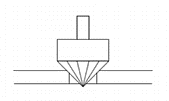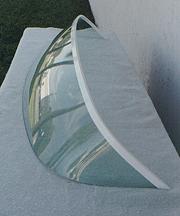
---- Drilling Acrylic ----
(and most other hard plastics)  Another specialty drill bit for hard plastics is one that has diamond dust bonded to the tip surface. These are the drills for superior performance. No chipping, cracking or gumming, even on extruded material. Regular high speed twist drills can be used, but need modification to keep the cutting edge from grabbing and fracturing the plastic. Modify the bit by grinding small flats onto both cutting edges, so the bit cuts with a scraping action. If the drill is correctly sharpened and operated at the correct speed, two continuous spiral ribbons will emerge from the hole. Another critical factor with acrylic is heat generated from the bit. If the bit is less than sharp then you will have to drill very slowly (either slow bit speed or retracting the bit often). Sharp bits can be drilled quicker but you still have to retract the bit often to let the material cool down. Over heating will result in a crystalline sugar-like melting around the hole. Also try not to punch the bit through the material when you are almost through the material. This may chip the back side of the acrylic. When drilling acrylic always use a cutting fluid, water works well. A water soluble oil is what the pros use. Otherwise your drill will heat up and melt the acrylic and you'll get an oversize hole. Also use a smaller diameter drill bit to pilot drill the hole. A pilot hole will reduce the tendency of your bit to wander. Finally, once you've drilled your hole(s), use a counter sink to relieve the sharp 90° corner from both sides of the hole. This is where the possibility of stress cracks will occur...  To get the feel of drilling acrylic and other hard plastics, spend some time testing with scrap stock of the same material and thickness. Don't just rush in and possibly crack or chip some thing like the $575 Bertram 31 windshield shown below...  (click for more details) Have fun! Feel free to download and print this article, but please don't use it on a website without linking it to Bertram31.com. Capt Patrick McCrary Bertram31.com 834 Scott Dr., LLANO, TX 78643 Telephone 325.248.0809 Web site questions or comments to: bertram31@bertram31.com |
